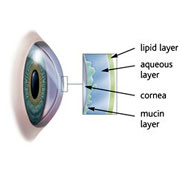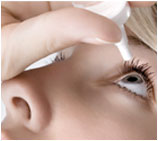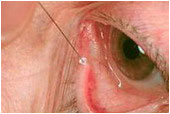Corneal Infection Corneal Transplant Amniotic Membrane
Dry eye syndrome is one of the most common eye problem treated by eye physicians. Dry eyes occur when there are not enough tears to keep your eyes lubricated, or the tears that are produced do not spread evenly across the eyes. Normally eyes are covered with a thin invisible film of tears which are the lubricating agent of the eye surface. Dry eyes occur when the lacrimal gland that makes the tears dries up. Also, if your tears do not spread properly, they may feel irritated and watery. There are fewer tears at night, so your eye may be sore and a little sticky in the morning.
What is Tear Film?
 The tears
form a film in the exposed surface of the eye. It is made up
of three layers. The inner mucus layer coats the cornea,
forming a foundation so the tear film can adhere to the eye.
The middle aqueous layer provides moisture and supplies oxygen
and other important nutrients to the cornea. This layer is
made of 98 percent water along with small amounts of salt,
proteins and other compounds. The outer lipid layer is an oily
film that seals the tear film on the eye and helps to prevent
evaporation.
The tears
form a film in the exposed surface of the eye. It is made up
of three layers. The inner mucus layer coats the cornea,
forming a foundation so the tear film can adhere to the eye.
The middle aqueous layer provides moisture and supplies oxygen
and other important nutrients to the cornea. This layer is
made of 98 percent water along with small amounts of salt,
proteins and other compounds. The outer lipid layer is an oily
film that seals the tear film on the eye and helps to prevent
evaporation.
 Tears are formed in several glands around
the eye. The water layer is produced in the lacrimal gland,
located under the upper eyelid. Several smaller glands in the
lids and conjunctiva, make the oil and mucus layers. With each
blink, the eyelids spread the tears over the eye. Excess tears
flow into two tiny drainage ducts in the corner of the eye by
the nose. These ducts lead to tiny canals that connect to the
nasal passage. The connection between the tear ducts and the
nasal passage is the reason that crying causes a runny nose.In
addition to lubricating the eye, tears are also produced as a
reflex response to outside stimulus such as an injury or
emotion. However, reflex tears do little to soothe a dry eye,
which is why someone with watery eyes may still complain of
irritation.
Tears are formed in several glands around
the eye. The water layer is produced in the lacrimal gland,
located under the upper eyelid. Several smaller glands in the
lids and conjunctiva, make the oil and mucus layers. With each
blink, the eyelids spread the tears over the eye. Excess tears
flow into two tiny drainage ducts in the corner of the eye by
the nose. These ducts lead to tiny canals that connect to the
nasal passage. The connection between the tear ducts and the
nasal passage is the reason that crying causes a runny nose.In
addition to lubricating the eye, tears are also produced as a
reflex response to outside stimulus such as an injury or
emotion. However, reflex tears do little to soothe a dry eye,
which is why someone with watery eyes may still complain of
irritation.
What are the Signs & Symptoms of Dry Eye?
Persistent dryness, scratching and burning in your eyes are signs of dry eye syndrome. These symptoms alone may be enough for your eye doctor to diagnose dry eye syndrome. Some people also experience a "foreign body sensation," the feeling that something is in the eye. And it may seem odd, but sometimes watery eyes can result from dry eye syndrome, because the excessive dryness works to over-stimulate production of the watery component of your eye's tears. Affected persons may also have blurred vision that improves with blinking. Some patients have increased discomfort after periods of reading, watching TV, or working on a computer
What Causes Dry Eye?
Dry eye syndrome has several causes. One of the most common reasons for dryness is simply the normal aging process. As we grow older, our bodies produce less oil - 60% less at age 65 then at age 18. This is more pronounced in women, who tend to have drier skin then men. The oil deficiency also affects the tear film. Without as much oil to seal the watery layer, the tear film evaporates much faster, leaving dry areas on the cornea.
It can occur as a side effect of many medications, such as antihistamines, antidepressants, certain blood pressure medicines, Parkinson's medications, and birth control pills, or because you live in a dry, dusty or windy climate.
If your home or office has air conditioning or a dry heating system, that too can dry out your eyes.
Dry eyes are also a symptom of systemic diseases such as Lupus, Rheumatoid Arthritis, Rosacea or Sjogren's Syndrome (a triad of dry eyes, dry mouth, and rheumatoid arthritis or lupus).
Long-term contact lens wear is another cause; in fact, dry eyes are the most common complaint among contact lens wearers. Recent research indicates that contact lens wear and dry eyes can be a vicious cycle. Dry eye syndrome makes contact lenses feel uncomfortable, and the rubbing of the lenses against the conjunctiva seems to be a cause of dry eyes.
Another cause is insufficient blinking, such as when you're staring at a TV or computer screen all day. Stopping periodically to rest and blink keeps the eyes more comfortable.
Incomplete closure of the eyelids, eyelid disease and a deficiency of the tear-producing glands are other causes. Dry eye syndrome is more common in women, possibly due to hormone fluctuations. Recent research suggests that smoking, too, can increase your risk of dry eye syndrome.
How to Diagnose Dry Eye?
There are several methods to test for dry eyes. Your doctor will first assess the underlying evaluating production, evaporation rate and quality of the tear film. Special drops that highlight problems could be used to diagnose the presence and extent of the dryness.
What is the Treatment of Dry Eye?
Dry eye syndrome is an ongoing condition that may not be cured (depends on the cause), but the accompanying dryness, scratchiness and burning can be managed. Treating dry eye problems is important not only for comfort, but also for the health of the cornea.
 Artificial Tears - When it
comes to treating dry eyes, everyone's needs are a little
different. Most patients find relief simply from using
lubricating artificial tears on a regular basis. Some of these
products are watery and alleviate the symptoms, while others
are thicker and adhere to the eye longer. Preservative-free
tears are often recommended because they have fewer additives
that could potentially irritate.
Artificial Tears - When it
comes to treating dry eyes, everyone's needs are a little
different. Most patients find relief simply from using
lubricating artificial tears on a regular basis. Some of these
products are watery and alleviate the symptoms, while others
are thicker and adhere to the eye longer. Preservative-free
tears are often recommended because they have fewer additives
that could potentially irritate.
Cyclosporine Eye Drops - Cyclosporine eye drops go one step further to help your eyes to increase tear production.
 Punctal Plugs - Closing the
drainage channels of the tears in the eyelid with special
inserts called punctal plugs is another option. This works
like closing a sink drain with a stopper. These special plugs
trap the tears on the eye, keeping it
moist.
Punctal Plugs - Closing the
drainage channels of the tears in the eyelid with special
inserts called punctal plugs is another option. This works
like closing a sink drain with a stopper. These special plugs
trap the tears on the eye, keeping it
moist.
 General Measures - There are
also simple lifestyle changes that can significantly improve
irritation from dry eyes. For example, drinking eight to ten
glasses of water each day keeps the body hydrated and flushes
impurities. Make a conscious effort to blink frequently -
especially when reading or watching television. Avoid rubbing
the eyes. This only worsens the irritation. The use of
sunglasses with covers on the sides often helps patients keep
away allergens and irritants as well as reduces the
evaporation of tears.
General Measures - There are
also simple lifestyle changes that can significantly improve
irritation from dry eyes. For example, drinking eight to ten
glasses of water each day keeps the body hydrated and flushes
impurities. Make a conscious effort to blink frequently -
especially when reading or watching television. Avoid rubbing
the eyes. This only worsens the irritation. The use of
sunglasses with covers on the sides often helps patients keep
away allergens and irritants as well as reduces the
evaporation of tears.


2) Organ (Cornea)
Transplant Centre


